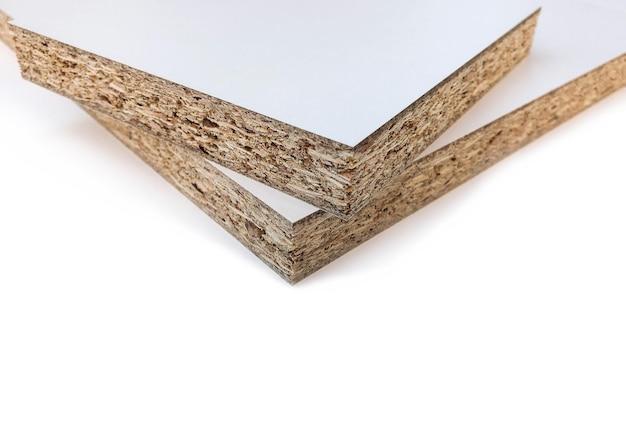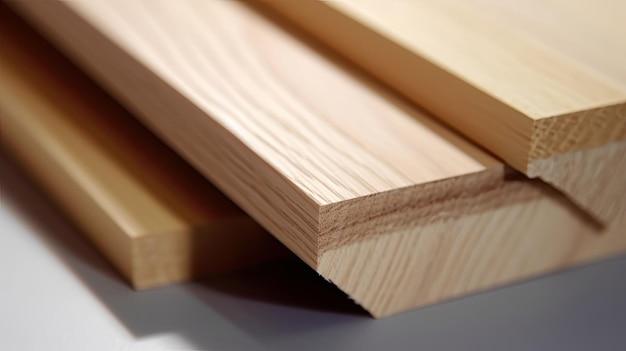Particle board is a widely used engineered wood product that has gained popularity for its affordability and versatility. But have you ever wondered how thick particle board actually is? In this blog post, we’ll delve into the world of particle board and answer questions like “What is the thickest particle board?” and “How thick is particleboard flooring?”
We’ll also address common concerns about using particle board, such as whether wood screws can be used in it and if you need special screws for this material. Moreover, we’ll explore the differences between particle board and other materials like plywood and MDF, examining their strengths and weaknesses. Additionally, we’ll shed light on the utilization of particle board in IKEA cabinets and explain the difference between particle board and OSB.
So, whether you’re a DIY enthusiast or simply curious about the properties of particle board, you’ve come to the right place. Let’s dive in and uncover everything you need to know about the thickness and applications of particle board.
How Thick Is Particle Board
Particle board is a widely used material in the world of furniture and construction. It’s known for its affordability, versatility, and strength. But when it comes to the thickness of particle board, what should you be looking for? Let’s dive right in and explore the different thickness options available for this wood-based product.
Standard Thickness Options
When it comes to particle board, there are three main thickness options you’ll typically find: 1/2 inch, 3/4 inch, and 1 inch. These measurements refer to the thickness of the board itself and are widely available in the market. So, which one should you choose? Well, that depends on your specific needs and the project at hand.
1/2 Inch: “The Versatile Option”
If you’re working on a project that requires a lightweight and flexible material, then the 1/2 inch particle board might be just what you need. It’s perfect for making shelves, cabinets, or even as a base for laminate or veneer surfaces. Just keep in mind that this thickness might not be suitable for heavy-duty applications.
3/4 Inch: “The All-Rounder”
Considered the standard thickness for particle board, the 3/4 inch option offers a good balance between flexibility and durability. It’s an ideal choice for various furniture pieces like tables, desks, and bookshelves. This thickness can handle moderate loads and is commonly used in both residential and commercial settings.
1 Inch: “The Heavy-Duty Hero”
If you’re looking for maximum strength and stability, the 1-inch particle board is the way to go. This thick board can withstand heavy loads and is commonly used for countertop surfaces, workbenches, and other robust applications. Just be aware that it will add some weight to your project, so it might not be suitable for all situations.
Custom Thickness and Beyond
While the above-mentioned thickness options are the most commonly available, it’s worth noting that particle board can be custom-made to fit specific requirements. If your project calls for a particular thickness not found in stores, you can reach out to manufacturers who offer custom cutting services. This way, you can ensure that the particle board perfectly matches your needs.
Considerations When Choosing Thickness
When determining the ideal thickness for your particle board, consider factors such as the intended use, load-bearing capacity, and cost. Thicker boards generally offer more durability and strength, but they may not be necessary for every project. It’s essential to strike a balance between affordability and functionality.
In the world of particle board, thickness matters. Choosing the right thickness plays a crucial role in the success and longevity of your project. Whether you opt for the versatile 1/2 inch, the all-rounder 3/4 inch, or the heavy-duty 1 inch, consider your specific needs and always find the perfect fit. Happy woodworking!
*Note: This blog post is purely informative and does not constitute professional advice.
FAQ: How Thick Is Particle Board
Welcome to our FAQ section all about the thickness of particle board! We know you’ve got questions, and we’ve got answers. We’ve compiled the most common questions people have regarding particle board thickness and provided informative and humorous responses. So, let’s dive right in!
What’s the Thickest Particle Board
When it comes to particle board, you’ll typically find a range of thickness options available. The thickest commonly available particle board is around 1 1/8″ (or 29mm). However, it’s important to note that the thickness may vary depending on the manufacturer and the specific product you’re looking at.
Can You Use Wood Screws in Particle Board
Absolutely! Particle board is known for its versatility, and you can definitely use wood screws in it. Just make sure you choose the right length of screws to properly secure your materials together. And hey, isn’t it fascinating how particle board can handle the screw-tiny?
How Much Does a 4×8 Sheet of Particleboard Weigh
Ah, the weighty subject of particleboard! A 4×8 sheet of particleboard generally weighs between 70 to 100 pounds (31 to 45 kilograms). Of course, the weight can vary depending on the specific type and thickness of the particle board. So, be prepared for some heavy lifting if you’re working with this material.
How Wide is Particle Board
Particle board typically comes in standard widths, just like your favorite brand of potato chips. The most common width you’ll find is 4 feet (or 1.22 meters). However, you can also find narrower options if you need to embark on a project with a little less breadth. Whatever width you choose, particle board’s got you covered!
How Thick is Particleboard Flooring
When it comes to particleboard flooring, thickness matters, just like when you’re determining if you need another slice of pizza. The standard thickness for particleboard flooring is around 3/4″ (or 19mm). This thickness offers stability and durability, making it suitable for a variety of flooring applications. But remember, thicker isn’t always better, especially for your waistline!
Can You Drill into Particle Board
Oh, absolutely! You can drill into particle board without any problems. Just make sure you use a drill bit suitable for wood and adjust your drilling speed accordingly. Particle board’s like a friendly neighbor, always ready to accommodate your drilling needs (unlike that one neighbor who always borrows your tools and never returns them).
Do You Need Special Screws for Particle Board
No need for any fancy-schmancy screws here! Regular wood screws will do the trick just fine when it comes to particle board. Just be sure to choose the appropriate length and gauge for your project. Particle board isn’t high-maintenance like that distant relative who only visits on holidays.
Is Particle Board Cheaper Than Plywood
Ah, the age-old question of finances. Particle board is generally more affordable than plywood. So, if you’re looking for a budget-friendly option for your project, particle board has got your back (and your wallet)! Plus, who doesn’t love saving a little dough-re-mi?
How Do You Attach Particle Board to a Wall
Attaching particle board to a wall is a breeze. You can use various methods such as screws or nails, depending on the specific application and the weight you’ll be placing on the board. Whether you’re a DIY enthusiast or a seasoned pro, particle board lets you effortlessly create wall-mounted masterpieces (no cape required).
Are IKEA Cabinets MDF or Particle Board
IKEA cabinets are typically made of particle board, not MDF. Particle board offers a sturdy and cost-effective option for those stylish IKEA cabinets you’ve been eyeing. So, go ahead and organize your life with some Swedish flair!
Is Particle Board Stronger Than Plywood
While particle board has its strengths, plywood takes the crown for sturdiness. Plywood’s layers of cross-grained wood veneers make it stronger and more resistant to warping than particle board. So, if you’re in need of some serious strength, plywood is the heavyweight champion it’s time to call upon!
Is Particle Board Stronger Than OSB
When it comes to strength, particle board falls short compared to OSB (oriented strand board). OSB is engineered with pressed wood strands, making it tougher and more durable than regular old particle board. So, if you crave that extra strength, OSB is the way to go!
What is IKEA Particleboard
IKEA particleboard is the material used to create a range of their furniture and cabinets. This particleboard is made from wood chips, shavings, and sawdust bonded together with resin. The result? Durable, affordable furniture that can help transform your living space without breaking the bank (or your spirit)!
What is the Difference Between OSB and Particle Board
The main difference between OSB and particle board lies in their composition and manufacturing process. Particle board is made from wood particles combined with resin, while OSB comprises pressed wood strands bonded together. OSB tends to be stronger and more moisture-resistant than particle board. It’s like comparing a performance sedan to a trusty compact car – both have their place depending on your needs!
Does IKEA Use MDF
While IKEA uses a variety of materials across their products, MDF (medium-density fiberboard) is not commonly used in their furniture or cabinets. Particleboard and solid wood tend to be the go-to materials in IKEA’s vast array of designs. So, go ahead and explore the world of IKEA furnishings, knowing that MDF is not a main player.
Which is Stronger: Particle Board or MDF
When it comes to strength, MDF (medium-density fiberboard) takes the trophy. Its dense composition makes it more robust than particle board. However, particle board still offers decent strength for most applications. So, if you’re looking for something strong but don’t need to move mountains, particle board is your trusty companion.
Can You Sand Down Particleboard
You can definitely sand down particleboard to achieve a smoother finish. However, keep in mind that sanding might reveal the particleboard’s inner layers, which might not be as pretty as the surface. Be sure to use a fine-grit sandpaper and take it slow and steady. Particleboard appreciates a gentle touch, just like your grandmother’s heirloom china.
Can You Paint Particle Board
Absolutely! You can paint particle board to give it a fresh new look. Just make sure to properly clean and prime the surface before applying the paint. Choose your favorite color, grab that brush, and let your creativity color your world!
And there you have it, folks – our FAQ-packed guide to particle board thickness! We hope this section has satisfied your curiosity and provided you with the knowledge needed to tackle your particle board-related projects. Remember, thickness matters, but so does your creativity and resourcefulness. Happy woodworking!
Note: The information provided in this article is for informational purposes only and does not constitute professional advice. Consult a qualified professional for specific recommendations regarding your project.

